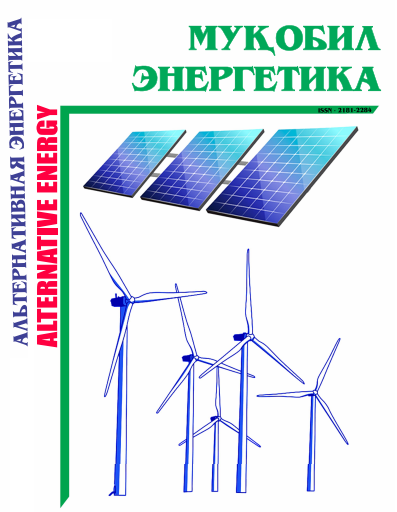MAGNETIC PROPERTIES OF SILICON DOPED WITH IMPURITY MANGANESE ATOMS
Keywords:
silicon, manganese, impurity, diffusion, nanocluster, hysteresis loopAbstract
Abstract. Introduction. Studies of the magnetic properties of silicon samples doped with manganese impurity atoms in the low temperature region (T=30 K) revealed ferromagnetic properties that had the following parameters Ms=3.41·10-3 emu/cm-3 (saturated magnetization),Mr=4.24·10-4 emu/cm-3 (residual magnetization) and Hc=158 Oe (coercive force). The possibility of creating magnetic sensors and spintronic devices based on silicon samples diffusion-doped with impurity manganese atoms is shown. It has been shown that silicon samples doped with manganese impurity atoms can be considered as a new magnetic semiconductor material.
Methods and materials. The magnetic properties of silicon samples doped with manganese impurity atoms were studied in a Quantum Design MPMS-3 SQUID VSM magnetometer at a temperature T = 30 K. The results of the study showed that at low temperatures T < Tcr (Tcr is the Curie temperature) in silicon samples with impurity nanoclusters manganese atoms exhibit ferromagnetic properties.
Results. A study of the magnetic properties of p-Si <B, Mn> samples in the low temperature region T = 30 K showed that a ferromagnetic state appears. These studies showed that by diffusion of impurity manganese atoms into silicon, a new magnetically sensitive semiconductor material can be obtained. It has been established that the magnetic properties of the obtained samples depend on the charge and spin state of the impurity manganese atoms in the formed nanoclusters.
Conclusion. The high concentration of highly charged nanoclusters of manganese impurity atoms (BMn4) formed and the ferromagnetic state observed in them at T = 30 K with parameters allows this material to be used to create new types of devices in spintronics.
Downloads
References
[1] Бахадырханов М.К., Исамов С.Б., Зикриллаев Н.Ф., Хайдаров К. Наноразмерная варизонная структура в кремнии с многозарядными нанокластерами // Микроэлектроника. 2013. Т. 42. № 6. С. 444-446.
[2] Таскин А.А., Тишковский Е.Г. Образование квазимолекул Se в кремнии легированном селеном. ФТП, 1998, т. 32, №11, с. 1306.
[3] Фистуль В.И., Казакова В.М., Бобриков Ю.А., Рябцев А.В., Абдурахманов К.П., Зайнабидинов С., Камилов Т.С., Утамурадова Ш.Б. О состоянии примесных ионов марганца в кремнии // Физика и техника полупроводников. – Санкт–Петербург, 1982.– Т. 16.– В.5– С. 939-941.
[4] Юнусов М. С. и др. О некоторых закономерностях электронного спектра примесных атомов d – элементов в кремнии. ФТП. 1995.т.4. с.714.
[5] Мирсагатов Р.М. Метасбильность центров марганца в твердых растворах кремний-германий. ФТП. 1992, в.3, с.427.
[6] М.К. Бахадырханов, С.Б. Исамов, Н.Ф. Зикриллаев., Х.М. Илиев, Г.Х. Мавлонов, С.В. Ковешников, Ш.Н. Ибодуллаев, Функциональные возможности кремния с нанокластерами атомов марганца. // Электронная обработка материалов. 2020. т. 56. № 2. С. 21-27.
[7] М. Bolduc, C. Awo-Affouda, A. Stollenwerk, M. B. Huang, F. G. Ramos, G. Agnello, and V. P. LaBella, Ферромагнетизм при температуре выше комнатной в Si, имплантированном ионами Mn. Physical Review B 71, 033302 (2005).
[8] С. Awo-Affouda, M. Bolduc, M. B. Huang, F. G. Ramos, K. A. Dunn, B. Thiel, G. Agnello, and V. P. LaBella, Влияние температуры отжига на структуру ферромагнитного кремния, имплантированного Mn, Journal of Vacuum Science and Technology, A 24, 1644 (2006).
[9] М.K. Bakhadyrkhanov, Kh.M. Iliev, G.Kh. Mavlonov, K.S. Ayupov, S.B. Isamov, S.A. Tachilin, Кремний с магнитными нанокластерами атомов марганца — новый класс фотомагнитных материалов, Technical Physics, M 64(3) 385 (2019).
[10] Liu Xingchong., Zhang Fengming. Ferromagnetism dependence on hole carriers in polycrystalline silicon films co-doped with Mn and B. Journal of Magnetism and Magnetic Materials, 2009. p. 4103-4107.
[11] F.M. Zhang, Y. Zeng, J. Gao, X.C. Liu, X.S. Wu, Y.W. Du. Ferromagnetism in Mn-doped silicon. Journal of Magnetism and Magnetic Materials, 2004. p. 216-218.
[12] Y.H. Kwon, T.W. Kang, H.Y. Cho, T.W. Kim. Formation mechanism of ferromagnetism in Si1-x Mnxdiluted magnetic semiconductors, Solid State Communications, 136 (2005) 257–261.
[13] Z.M. Saparniyazova., M.K. Bakhadyrkhanov., O.E. Sattorov., N. Norkulov., D. Zh. Asanov., Interaction between multiply charged manganese nanoclusters and sulfur atoms in silicon. Inorganic materials, 48(4), pp. 325-328, 2012.
[14] Z. A. Yunusov, S. U. Yuldashev, K. T. Igamberdiev, Y. H. Kwon, T. W. Kang, M. K. Bakhadyrkhanov, S. B. Isamov, N. F. Zikrillaev, Journal of the Korean Physical Society, Ferromagnetic States of p-type Silicon Doped with Mn, 64(10), 1461 (2014).
[15] Н. Ф. Зикриллаев, С. В. Ковешников, Левент Трабзон, Г. X. Мавлонов, Б. К. Исмайлов, Т. Б. Исмаилов, Ф. Э. Уракова., Электронная обработка материалов, Ферромагнитные свойства кремния, легированного атомами марганца. 2024, 60(3), 28–33.






